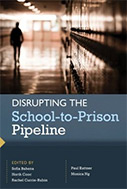Disrupting the School-to-Prison Pipeline

Editors: Sofia Bahena, North Cooc, Rachel Currie-Rubin, Paul Kuttner, and Monica Ng
Publisher: Cambridge, MA: Harvard University Press, 2012. 288p.
Reviewer: Eliza P. Fabillar | November 2013
Disrupting the School-to-Prison Pipeline is a well-informed, comprehensive effort at understanding a trend of the past two to three decades wherein children are channeled out of public schools and into the juvenile and criminal justice systems. The book also provides a balanced overview of events that have led to changes in policies and practices designed to improve the experiences of young people in schools and in the juvenile system. It succeeds in bringing together different voices from youth, education practitioners, activists, and academics, and in presenting alternatives to criminalization-oriented social policies.
Several authors describe the ways in which the school-to-prison pipeline is the result of several legal, political, social, and economic factors. Two key factors addressed in the book include (1)“zero-tolerance” school policies, which have led to the criminalization of young people and affected a disproportionate number of minority youth; and (2) high-stakes standardized tests, which push out low performing students (many of whom live in poverty, have histories of abuse and neglect, and have disabilities).
Disrupting the School-to-Prison Pipeline consists of four main parts and twenty one chapters. The first part, Discipline and Justice in Schools, provides a historical context, case studies of out-of-school exclusionary suspensions, and statistical trends in the U.S. correctional system. The second part, Education in Detention, includes curriculum and educational approaches, teacher reflections, and the experiences of educators working in the juvenile justice system and in prisons. The third part, Transforming the Pipeline, illustrates strategies for grassroots organizing, youth organizing, and alternatives to incarceration. The fourth and final part is a review of other books that explore different aspects of the school-to-prison pipeline.
The book includes several chapters written by people who share their personal experiences in public schools or in the juvenile and criminal justice systems. These first-hand stories are interspersed throughout the main thematic sections, and allow the reader to gain a deeper understanding of how policies, institutional structures, laws, and stereotypes can affect people of color and of lower socioeconomic background. Robert Wilson writes about his arrest, his son’s suspension from school, and his experiences at a charter school in jail compared to his son’s experiences in a public high school. Seth Cooper writes about his suspension from high school, subsequent arrests for several felonies, and efforts to receive a GED. Elizabeth A. Reid writes about her childhood experiences of not having enough to eat at home, being physically abused, dealing drugs as a child, and her transformative experience at a community college. Bobby Dean Evans, Jr. writes about his negative experiences in special education classes, his expulsion which led to incarceration, and how his life changed after going through the Prison University Project. Michel Satterfield describes how he dropped out of school, ended up in prison, and how he finally gained hope when he received his GED in jail. Christopher Dankovich writes about his life in prison since he was fifteen years old and his experience as a tutor to prisoners. Starcia Ague writes about her childhood living in the midst of criminal activities and poverty, her five and a half years of incarceration, and her subsequent work in juvenile justice reform. While these cases illustrate the plight of the authors in a system that disproportionately affects minority youth, they also represent examples of resilience, and the role that effective education can play in improving the lives of disadvantaged youth.
In Part I, Discipline and Justice, the authors provide a history and overview of disciplinary policies in U.S. public schools. Pedro Noguera points to the late 19th century when schools served as agents of control, and social goals and efficiency models were used to educate the workforce. Peter Sipe makes a comparison of the physical environment and disciplinary policies of the middle school where he taught with a New York prison, and describes the disorder and stress that is cultivated in these two institutions. Daniel J. Losen analyzes federal and state data on out-of-school suspensions and the effect of such policies on students of color since the 1970s. The final chapter in this section describes a roundtable discussion focused on the practice of restorative justice in Boston schools as an alternative to harsh disciplinary policies.
In Part II, Education in Detention, the authors provide examples of innovative instructional strategies that have been implemented in public schools and in prisons. Filmmaker Joseph Cambone writes about “Anne”, who is a teacher at a residential school for boys with severe emotional and behavioral challenges, and the pedagogical approaches she uses in the classroom to create a safe space for learning. Douglas Price describes a literacy approach and writing strategy for empowering students in a prison charter school. Joanne Karger, David H. Rose, and Kathleen B. Boundy propose a framework called “Universal Design for Learning” (UDL) designed to improve the quality of education in juvenile corrections facilities. Sabina E. Vaught explores the institutional narrative of Whiteness and the psychoanalytic framework of racist melancholia in her ethnographic study at a prison for juvenile males; she proposes that scholars use this lens to analyze inequitable structures and systems. Kathy Boudin implemented critical literacy strategies and a participatory literacy program at a women’s correctional facility.
In Part III, Transforming the Pipeline, the authors describe strategies currently being used to disrupt the school-to-prison pipeline. Kavitha Mediratta explores the role of grassroots organizations in reforming zero tolerance policies; their contributions eventually led to the creation of the federal Supportive School Discipline Initiative (SSDI) in 2011. Mediratta examines efforts led by youth organizations, legal and research organizations, and scholars.
Among the groups and individuals cited are: Youth United for Change, Schools Not Jails Campaign, Generation Y, The Advancement Project, Harvard Civil Rights Project, American Civil Liberties Union, and the Southern Poverty Law Center, Pedro Noguera, Russell Skiba, and Anne Gregory. According to Mediratta, grassroots initiatives have led to statistical and qualitative studies on racial bias and trends in school discipline disparities, an increase in media coverage in 2011-2012, and changes in policies and politics. At the end of Part III, Jane Hereth, Mariame Kaba, Erica R. Meiners, and Lewis Wallace write about restorative justice (RJ) alternatives in Chicago Public Schools. According to the authors, RJ emphasizes repairing the harm caused by crime or conflict and takes into account the needs of victims, offenders, and others affected by the situation. The authors describe some pitfalls of Restorative Justice, including limited funds, competing educational priorities, and issues of sustainability within a punitive system. An alternative described rather briefly is Transformative Justice; this approach questions and challenges structural inequality and works toward transforming or building more just communities.
The last chapter summarizes key challenges and strategies for disrupting the school-to-prison pipeline that are addressed in several academic books. It highlights multiple facets of the issue, including curriculum and pedagogy, school discipline policies, laws that discriminate against subgroups of students, and educational national policies. The co-editor, Paul Kuttner, also points out that each of these facets is too often understood in isolation.
Taken together, the chapters in this book offer insight on and a sense of hope in disrupting the school-to-prison pipeline. It also pinpoints the issues and challenges that still need to be addressed. That said, however, the book felt a bit disjointed and redundant at times, with overlapping information across chapters and parts. It might have also been useful for the editors to make more connections among the themes that emerged. For example, a question appears at the end of chapter 19: “What would transformative justice practices within schools look like?” In many ways, this is related to the youth led practices and projects detailed in Part III. As described in Chapter 17, students involved in youth programs conducted quantitative and qualitative research, questioned existing policies and laws, engaged in critical inquiry, synthesized their research findings, wrote about their study, and participated in advocacy and public awareness work on issues they cared about. That kind of learning involves reading, writing, mathematics, speaking, and research, which are relevant across core disciplinary subjects. That kind of student work can be considered as a transformative justice practice as students were empowered to challenge inequities in the system and to identify creative solutions to address systemic problems.
In a June 2013 interview of Michelle Alexander (author of The New Jim Crow: Mass Incarceration in the Age of Colorblindness), conducted by Jody Sokolower of Rethinking Schools, Alexander noted:
I am in the process of working with others trying to develop curriculum and materials that will make it easier to talk to young people about these issues in ways that won’t lead to paralysis, fear, or resignation, but instead will enlighten and inspire action and critical thinking in the future.
Disrupting the School-to-Prison Pipeline provides a rallying point for scholars like Michelle Alexander to work more closely with other educators, activists, and legal professionals.
The ideas in this book can help young people of diverse backgrounds to see themselves as active and critical agents in a democratic society, and can empower them to improve the justice system.
Eliza P. Fabillar is senior project director at Education Development Center, Inc. She developed the Law and Justice education program


